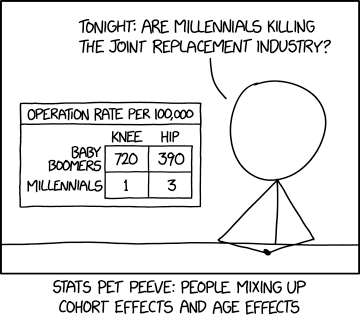-
Notifications
You must be signed in to change notification settings - Fork 0
/
Copy pathbias.qmd
151 lines (104 loc) · 5.2 KB
/
bias.qmd
1
2
3
4
5
6
7
8
9
10
11
12
13
14
15
16
17
18
19
20
21
22
23
24
25
26
27
28
29
30
31
32
33
34
35
36
37
38
39
40
41
42
43
44
45
46
47
48
49
50
51
52
53
54
55
56
57
58
59
60
61
62
63
64
65
66
67
68
69
70
71
72
73
74
75
76
77
78
79
80
81
82
83
84
85
86
87
88
89
90
91
92
93
94
95
96
97
98
99
100
101
102
103
104
105
106
107
108
109
110
111
112
113
114
115
116
117
118
119
120
121
122
123
124
125
126
127
128
129
130
131
132
133
134
135
136
137
138
139
140
141
142
143
144
145
146
147
148
149
150
151
---
title: "Bias"
---
## Definition of bias
Definition: Any systematic error in the design or implementation of an epidemiological study resulting in a conclusion which is different from the truth
Any systematic error in design, conduct or analysis of study that results in mistaken estimate of an exposure’s effect on risk of disease
- Unlike chance and confounding it cannot be quantified
- It can be minimized with the design and methodology of a study
- The effect of bias will be an estimate that is either above or below the true value, depending on the direction of the systematic error
## Believe an estimated effect
::: {.panel-tabset}
## Bias

## Chance

## Confounding
Confounding is a factor that influence both the cause and the effect of a causal relation
```{r, echo=FALSE, warning=FALSE, error=FALSE, message=FALSE}
library(ggplot2)
library(ggdag)
ggplot2::theme_set(ggdag::theme_dag())
plot_dag <- ggdag::dagify(
finger ~ smoking,
cancer ~ smoking,
exposure = "finger",
outcome = "cancer",
labels = c(
"finger" = "Having yellow fingers",
"cancer" = "Lung Cancer",
"smoking" = "Smoking"
)
) %>%
ggdag::tidy_dagitty(layout = "tree")
ggdag::ggdag(plot_dag, text = FALSE, use_labels = "label")
```
Barrett M (2024). ggdag: Analyze and Create Elegant Directed Acyclic Graphs. R package version 0.2.13.9000, https://r-causal.github.io/ggdag/, https://github.com/r-causal/ggdag.
:::
## Selection bias vs information bias
|Selection bias|Information bias|
|--|--|
|Systematic error in the selection of participants|Systematic error in the measurement of the exposure or outcome during data collection|
|Are the study participants the right people?|Have study participants been assigned to the right category? Is the information that we have about them correct / true?|
## Selection bias
Systematic error in the selection of participants
### Example for selection bias
- Aim: to assess mortality over 90 days in people with a positive SARS-CoV-2 infection
- Target population: People living in Stockholm with a positive SARS-CoV-2 infection
- Who could you recruit? Examples:
- Everyone with a positive test result recorded on the national health service database
- People hospitalized for COVID-19 complications
- Patients in a GP office with self-reported symptoms
::: {.panel-tabset}
### Who to choose

### What you get

:::
### Different kinds of selection bias
- Sampling bias (more likely to be selected in a sample)
- Ascertainment bias (referal, admission, diagnostic)
- Participation bias (self-selection, non-responste, loss to follow up, survival, health worker)
## Information bias
Occurs when there are systematic differences in the way data on exposure or outcome are obtained from the various study groups
### Missclassification
|Non-differential|differential|
|---|---|
|Random error|Systematic error|
|Misclassification of the exposure is EQUAL between cases & controls|Misclassification of the exposure DIFFERS between cases & controls|
|Misclassification of the outcome EQUAL between exposed & non-exposed|Misclassification of the outcome DIFFERS between exposed & non-exposed|
|Weakens the measure of association|Weakens the measure of association|
### Different kinds of information bias
- Reporting bias (recall bias, prevarication, social desireability, instrument bias)
- Observer bias (interviewer bias, )
## How to deal with bias
### Where to deal with bias
- Careful consideration is needed in the design of the study
- Aim to prevent bias at the protocol stage
- It is not possible to correct for bias at the analysis stage
### If bias is present
- Account for it when interpretating results
- Discuss if the magnitude of the association was likely to be overestimated or underestimated
### Minimising bias
::: {.panel-tabset}
## Selection Bias
- Clearly define the study population
- Make explicit case, control, and exposure definitions
Take cases and controls from the same population (same possibility of exposure)
- Select controls from more than one source (eg hospital and community controls)
- For cohort studies, select exposed and non-exposed without knowing their disease status
- Use techniques to maintain follow-up
## Information bias
- Standardise measurement instruments
- Questionnaires + trained staff (validation/closed questions)
- Administer instruments equally to:
- cases/controls
- exposed/unexposed
:::
## Conclusion
- It is very difficult to reduce bias in observational studies
- Do not try to hide the bias
- Discuss the bias as a limitation and always consider in which direction it may have changed the associations
## Reading more about bias
- [Althubaiti A. Information bias in health research: definition, pitfalls, and adjustment methods. J Multidiscip Healthc. 2016 May 4;9:211-7. doi: 10.2147/JMDH.S104807. PMID: 27217764; ](https://www.ncbi.nlm.nih.gov/pmc/articles/PMC4862344/)
- [Barrett M (2024) Common Structures of Bias](https://r-causal.github.io/ggdag/articles/bias-structures.html)